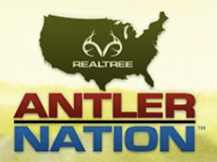Deer Hunting Regulations
Last Updated: Winter 2024
General Information
Wanton Waste
It is illegal to intentionally leave or abandon any portion of any wildlife that is commonly used as human food.
Dogs
Dogs may be used to hunt wildlife, except beavers, black bears, deer, elk, mink, muskrats, river otters, and turkeys. Hunting furbearers with dogs during daylight hours is prohibited statewide from Nov. 1 through the close of the November portion of firearms deer season and during the antlerless
and CWD portions in open counties. Dogs may not be used to hunt squirrels and rabbits during daylight hours of the November portion of firearms deer season in Butler, Carter, Dent, Iron, Madison, Oregon, Reynolds, Ripley, Shannon, and Wayne counties. Dogs may not be used to hunt furbearers, squirrels, and rabbits during daylight hours of the firearms portion of elk season in Carter, Reynolds, and Shannon counties.
While hunting, all dogs, except those used by waterfowl and game bird hunters, must wear a collar with the owner’s full name and address, Conservation Number, or telephone number. For training dogs, wildlife that can be hunted with dogs may be chased, but not taken. Only a pistol with blank ammunition may be used during daylight hours to train dogs during closed seasons. A hunting permit or exemption is required when training dogs that are chasing wildlife.
Hunting Near Floodwaters or Fire
Wildlife, except waterfowl, may not be pursued or taken while trapped or surrounded by floodwaters or while fleeing from floodwaters or fire. Flood-prone areas in southeast Missouri are closed to all hunting, except for waterfowl, during turkey and deer seasons when river levels exceed certain limits on local river gauges. To see if an area is open or closed for hunting, visit online.
Legal Firearm Methods
Legal firearm methods used to hunt wildlife — except beavers, mink, muskrats, river otters, turtles, and fish — are:
- Pistols, revolvers, and rifles propelling a single projectile at one discharge (may not be used for hunting game birds exceptcrow).
- Firearms powered by spring, air, or compressed gas (may not be used for hunting game birds except crow).
- Shotguns not larger than 10 gauge with the magazine cut off or plugged to reduce the capacity to not more than three shells in the magazine and chamber combined. The three-shell restriction does not apply to shotguns used while hunting black bears, deer, and elk, and during the Conservation Order for light geese.
Legal firearm methods used to hunt black bears, deer, elk, and turkeys are listed in the Spring Turkey Hunting Regulations and Information booklet, available online and at permit vendors in March; the Black Bear Hunting Digest and the Elk Hunting Digest, available online in May; and the Fall Deer & Turkey Hunting Regulations and Information booklet, available online and at permit vendors in July.
Fully automatic firearms are prohibited for all hunting.
Hunting Game Birds with Firearms
Shotguns are the only firearm allowed for hunting game birds except crows. Pistols, revolvers, rifles, and shotguns may be used to hunt crows.
Baiting
Baiting is not allowed for black bears, deer, elk, migratory birds, and turkeys. An area is considered baited for 10 days following complete removal of bait.
During the November portion statewide and antlerless and CWD portions in open counties, other wildlife may be hunted only with a shotgun and shot not larger than No. 4 or a .22 or smaller caliber rimfire rifle, pistol, or revolver. This does not apply to waterfowl hunters, elk hunters, trappers, or landowners on their land. Other provisions apply to furbearer hunters.
Special Provisions During Firearms Elk Season
During the firearms portion of elk season in Carter, Reynolds, and Shannon counties, other wildlife may be hunted only with a pistol, revolver, or rifle firing a .22 caliber or smaller rimfire cartridge, or a shotgun and shot not larger than No. 4. This does not apply to waterfowl hunters, deer hunters, trappers, or landowners on their land. During daylight hours, furbearer hunters must use legal elk hunting methods and have an unfilled elk permit and a small game permit.
Bows and Crossbows
Bows (longbows, compound bows, and recurve bows) and crossbows may be used to take wildlife during hunting seasons. Arrows containing any drug, poison, chemical, or explosive are prohibited. Illuminated sights, scopes, quickpoint sights, and hand-held string releasing mechanisms may be used.
Atlatls and Slingshots
Atlatls may be used to take wildlife except black bears. Slingshots may be used to take wildlife except black bears, deer, elk, and turkeys.
Motor Driven Vehicles and Boats
Motor driven conveyances may not be used to take, drive, or molest wildlife. Black bears, deer, and elk may not be hunted from a boat with a motor attached; however, a motor boat may be used to hunt other wildlife if the motor is shut off and the boat’s forward progress has stopped.
Artificial Lights and Night Vision Equipment
Artificial lights may be used only to hunt bullfrogs and green frogs, to hunt raccoons and other furbearing animals when treed by dogs, and to hunt coyotes from Feb. 1 through March 31. Using lights to search for, harass, or disturb other wildlife is prohibited.
Landowners may use lights on their property, but while doing so may not be in possession of, or be with someone who possesses, a firearm, bow, or other implement used to take wildlife.
You may not possess night vision, infrared, or thermal imagery equipment while carrying a firearm, bow, or other implement used to take wildlife, except:
- Landowners may use night vision, infrared, or thermal imagery equipment on their property to kill feral swine.
- Hunters may use night vision, infrared, or thermal imagery equipment to hunt coyotes from Feb. 1 through March 31.
Public Roadways
You may not take any wildlife from or across a public roadway with a firearm, bow, or crossbow. A Conibear®-type trap may be used adjacent to public roadways only if set under water in permanent waters.
Poisons, tranquilizers, chemicals, or explosives may not be used to take wildlife.
Electronic calls
Electronic calls or electronically activated calls may not be used or possessed while hunting except to pursue and take crows, furbearers, or light geese during the Conservation Order. Mouth and hand calls may be used at any time.
Giving Away Wildlife
You may give wildlife to another person, but it will continue to be a part of your daily limit for the day when taken. Black bears, deer, elk, and turkeys must be labeled with your full name, address, date taken, and Telecheck confirmation number. All other wildlife must be labeled with your full name, address, permit number, species, and the date taken. Wildlife given as a gift will be included in the possession limit of the person you give it to.
Wildlife Identification
You must keep wildlife you take separate or identifiable from wildlife taken by other hunters.
Possessing, Transporting, and Storing Wildlife
You can possess and transport wildlife as part of your personal baggage. It may be stored at your home, camp, place of lodging, or ina commercial establishment. If you store wildlife taken in Missouri, it must have the owner’s full name and address, or Conservation Number; permit number; species; and the date it was placed in storage. For black bears, deer, elk, and turkeys, also record the Telecheck confirmation number. If you transport wildlife, it must have the full name, address, and permit number of the taker and the date it was taken. To transport black bears, deer, elk, and turkeys, you must also include the Telecheck confirmation number. Commercially processed black bears, deer, and elk must be claimed or stored by the owner by May 1 following the season taken or the owner shall be in violation.
Unless federal regulations prohibit, you may buy, sell, or barter feathers; squirrel pelts; rabbit pelts; groundhog pelts; turkey beards, heads, bones, feet, spurs, wings, tails, and skins, including skins with the feathers, wings, and legs attached; and deer and elk heads, antlers, hides, and feet. They must be accompanied by a bill of sale showing the seller’s full name, address, and the number and species of the parts, and the full name and address of the buyer. Wildlife and wildlife parts, after mounting or tanning, also may be bought and sold.
People who receive or purchase deer and elk heads or antlers attached to the skull plate must keep the bill of sale as long as the heads or antlers are in their possession. The bill of sale must include the transaction date and a signed statement from the seller(s) attesting that the heads and antlers were taken legally.
Transporting Deer Species in Missouri
Carcasses of caribou, deer, elk, and moose harvested out of state may not be transported into Missouri. Only the following portions may be transported into Missouri:
- Meat that is cut and wrapped or that has been boned out
- Quarters or other portions of meat with no part of the spinal column or head attached
- Hides from which all excess tissue has been removed
- Antlers or antlers attached to skull plates or skulls cleaned of all muscle and brain tissue
- Upper canine teeth
- Finished taxidermy products
- Heads with capes attached (must be taken to a licensed taxidermist within 48 hours)
Additional rules apply to the transportation of deer taken in Missouri’s Chronic Wasting Disease Management Zone.
Some Conservation Areas Require NontoxicShot
Nontoxic shot is required for hunting doves on 26 conservation areas that have intensive dove hunting. In addition, 37 conservation areas require nontoxic shot for all hunting with shotguns. These areas have large wetlands where waterfowl and shorebirds concentrate in the spring and fall. Waterfowl hunters have been required by federal law to use nontoxic shot since 1991. These rules have reduced lead poisoning in wildlife.
Use or possession of lead shot for hunting doves is prohibited on the following conservation areas:
- Bilby Ranch Lake
- Blue Spring Branch
- Bois D’Arc
- Busch (August A.) Memorial
- Capps Creek
- Crowley’s Ridge
- Davisdale
- Fort Crowder
- Harmony Mission Lake
- Lamine River
- Logan (William R.)
- Maintz Wildlife Preserve
- Pacific Palisades
- Park (Guy B.)
- Peabody
- Pony Express Lake
- Reed (James A.) Memorial Wildlife Area
- Reform
- Shawnee Trail
- Sloan (Dr. O.E. and Eloise)
- Stockton Lake Management Lands
- Talbot (Robert E.)
- Truman Reservoir Management Lands (Bethlehem)
- Weldon Spring
- Whetstone Creek
- White (William G. and Erma Parke)
Use or possession of lead shot is prohibited for all hunting with a shotgun on the following conservation areas:
- Aspinwall Bend
- Black Island
- Bob Brown
- Church Farm
- Columbia Bottom
- Cooley Lake
- Coon Island
- Corning
- Deroin Bend
- Diana Bend
- Duck Creek
- Eagle Bluffs
- Franklin Island
- Frost Island
- Fountain Grove
- Four Rivers
- Grand Pass
- B.K. Leach Memorial
- Little Bean Marsh
- Little River
- Lower Hamburg Bend
- Marais Temps Clair
- Montrose
- Nishnabotna
- Nodaway Valley
- Otter Slough
- Ralph and Martha Perry
- Platte Falls
- Plowboy Bend
- Rose Pond
- Rush Bottoms
- Schell-Osage
- Settle’s Ford
- Ted Shanks
- Ten Mile Pond
- Thurnau
- Wolf Creek Bend
As of January 2023, shot types approved as being nontoxic by the U.S. Fish and Wildlife Service are:
- Bismuth-tin
- Copper-clad iron
- Corrosion-inhibited copper (CIC)
- Iron (steel)
- Iron-tungsten
- Iron-tungsten-nickel
- Tungsten-bronze (two types)
- Tungsten-iron-copper-nickel
- Tungsten-iron-polymer
- Tungsten-matrix
- Tungsten-polymer
- Tungsten-tin-bismuth
- Tungsten-tin-iron
- Tungsten-tin-iron-nickel
Bicycles and Horses on Conservation Areas
Bicycles and electric bicycles (e-bikes) are permitted only on roads open to vehicular traffic, multiuse trails, and service roads designated as such in the online conservation area atlas. Bikes and e-bikes may be prohibited on these paths during spring turkey season and firearms deer season.
Horses and horseback riding are permitted only on trails designated for their use and on roads open to vehicular traffic. For information on the use of bicycles and horses on specific conservation areas, visit online.
ATV Use
With limited exceptions, all-terrain vehicles (ATVs) are prohibited on conservation areas. It is illegal for anyone (except landowners and lessees on land they own or lease and certain agricultural workers) to drive ATVs in Missouri’s streams and rivers unless the ATV is on a crossing that is part of the highway system. Violators could lose their fishing and hunting privileges.
Definitions
Antlered Deer: A deer having at least one antler at least 3 inches long.
Antlered Elk: An elk having at least one antler at least 6 inches long.
Atlatl: A rod or narrow board-like device used to launch, through a throwing motion of the arm, a dart 5 to 8 feet in length.
Bow: A device drawn and held by hand and not fastened to a stock nor to any other mechanism that maintains the
device in a drawn position. This definition includes longbows, recurve bows, and compound bows.
Chase or Chased: The act of using dogs to follow wildlife or feral swine for the purpose of recreation or dog training, but not for the purpose of catching or taking that wildlife or feral swine.
Crossbow: A device for discharging quarrels or bolts, formed of a bow set crosswise on a stock, usually drawn by means of a mechanism and discharged by release of a trigger.
Days or Dates: All days and dates are inclusive. A day begins or ends at midnight, unless otherwise specified.
Firearm: Pistols, revolvers, and rifles propelling a single projectile at one discharge including those powered by spring, air, or compressed gas, and shotguns not larger than 10 gauge.
Furbearing Animals, Furbearers: Badger, beaver, bobcat, coyote, gray fox, red fox, mink, mountain lion, muskrat, nutria, opossum, raccoon, river otter, spotted skunk, striped skunk, and long-tailed weasel.
Note: Open seasons exist for all furbearers except mountain lions, spotted skunks, and longtailed weasels.
Game Birds: American coot, American woodcock, crows, ducks, Eurasian collared-dove, geese, gray partridge, mourning dove, northern bobwhite quail, ring-necked pheasant, ruffed grouse, sora rail, Virginia rail, white-winged dove, wild turkey, and Wilson’s snipe.
Note: Open seasons exist for all species except gray partridge and ruffed grouse.
Game Mammals: Black bear, deer, elk, groundhog (woodchuck), cottontail rabbit, jackrabbit, swamp rabbit, fox squirrel, gray squirrel, and furbearers as defined above. Note: Open seasons exist for all game mammals except jackrabbits, and for all furbearers except mountain lions, spotted skunks, and long-tailed weasels.
Handgun: Any firearm originally designed, made, and intended to fire a projectile from one or more barrels when held in one hand, and having a short stock designed to be gripped by one hand at an angle to and extending below the line of the bore(s), with a barrel less than 16 inches in
length, measured from the face of the bolt or standing breech (excluding any muzzle device not permanently attached to the barrel), and an overall length less than 26 inches as measured between the muzzle of the barrel and the rearmost portion of the firearm (excluding any pistol brace, muzzle device, or other firearm accessory not permanently attached to the firearm). The use of a pistol brace is specifically authorized, and a second hand may be used for support when firing.
Managed Deer Hunt: A prescribed deer hunt conducted on a designated area, which may include conservation areas, state parks, national wildlife refuges, military bases, private land, and city or county properties.
Muzzleloading Firearm: Any firearm capable of being loaded only from the muzzle including any firearm capable of having the powder or propellant loaded from the breech, provided the bullet or projectile(s) is/are capable of being loaded only from the muzzle.
Night-Vision Equipment: Optical devices (i.e., binoculars or scopes) using light amplifying circuits that are electrical or battery-powered.
Nonresident Landowner: Any nonresident who owns at least 75 acres in one contiguous tract in Missouri, or any member of the immediate household whose legal residence is the same as the nonresident landowner’s for at least the last 30 days.
Possessed and Possession: The actual and constructive possession and control of things referred to in the Wildlife Code of Missouri.
Public Roadway: The right of way which is owned either out-right or by easement by any public entity, or which is used by the general public for travel and is also regularly maintained by any public entity.
Pursue or Pursued: The act of trying to find, seek, or search for wildlife or feral swine for the purpose of taking wildlife or feral swine.
Resident Landowner: Any Missouri resident who owns at least 5 contiguous acres, and his or her immediate household members whose legal residence is the same as the landowner for at least the past 30 days. Ownership of at least 20 contiguous acres is required for resident landowner privileges to hunt black bears, deer, elk, and turkeys. See Chapter 20 of the Wildlife Code of Missouri for a more detailed definition.
Sell: To offer for sale or to exchange for compensation in any material form.
Take or Taking: Killing, trapping, snaring, netting, or capturing any wildlife or feral swine in any manner; also refers to pursuing, molesting, hunting, wounding; or the placing, setting, or use of any device in an attempt to take; and every act of assistance to every other person in taking or attempting to take any wildlife or feral swine.
Hunter-orange requirement
You must wear hunter orange if:
- You are hunting any species of game during firearms deer season. Some exceptions are allowed.
- You are hunting on an area that is having a managed fire-arms deer hunt.
- You are serving as a mentor to another hunter during firearms deer season or while on an area that is having a managed firearms deer hunt.
You must wear both a hunter-orange hat and a hunter-orange shirt, vest, or coat. The color must be visible from all sides. Camouflage orange does not satisfy this rule.
You don’t have to wear hunter orange if:
- You are hunting migratory game birds.
- You are archery hunting within municipal boundaries where the discharge of firearms is prohibited.
- You are hunting on federal or state land where deer hunting is restricted to archery methods.
- You are using an archery permit during the alternative methods portion.
- You are archery or small game hunting in a closed county during the antlerless portion.
- You are hunting small game or furbearers during the alter-native methods portion.
Assisting Other Deer and Turkey Hunters
During the youth portions of firearms deer season, adults who accompany youth hunters do not need a deer hunting permit. The adult must be 18 or older and hunter-education certified or born before January 1, 1967. At all other times, you must have a filled or unfilled deer hunting permit to assist others in taking deer, which includes participating in deer drives or enticing deer with calls or rattling antlers. You must have a filled or unfilled turkey hunting permit to assist others in taking turkeys, which includes calling. It is illegal to shoot a deer or turkey for another hunter. Party hunting where
hunters pool their permits is prohibited.
Methods Prohibited
- Electronic calls and electronically activated calls may not be used or possessed while hunting deer or turkeys.
- Dogs may not be used to take deer or turkeys.
- Artificial lights may not be used to spot, locate, or take deer or turkeys.
- Night vision equipment and thermal imagery devices may not be used or possessed while hunting.
- Poisons and tranquilizing drugs may not be used. Arrows, bolts, and darts must not contain chemicals or explosives.
- Slingshots may not be used to take deer or turkeys.
- Wildlife may not be taken from or across a public roadway with a firearm, bow, or crossbow.
- Deer and turkeys may not be taken from or with the aid of a motor-driven land conveyance or aircraft.
- Live decoys may not be used or possessed while hunting turkeys.
- Deer may not be taken while they are in a stream or other body of water, or from any boat with a motor attached, regardless of whether the motor is running or not.
- Deer may not be taken within any area enclosed by a fence greater than 7 feet in height, except in licensed hunting preserves.
Baiting Regulations
- Use of bait while hunting is illegal. Bait includes grain or feed placed or scattered to attract deer or turkeys.
- An area is considered baited for 10 days after complete removal of the bait.
- A hunter can be in violation if they take or attempt to take a deer or turkey by the aid of bait where the hunter knows or reasonably should know that the area is or has been baited.
- It is illegal to place bait in a way that causes others to be in violation of the baiting rule.
- Doe urine and other scents may be used to attract deer while hunting, as long as the scents are not used on or with grain or other food products.
- Mineral blocks, including salt, are not considered bait. However, mineral blocks that contain grain or other food additives are prohibited.
- The use of mineral blocks and salt is not allowed on conser-vation areas.
- It is legal to hunt over a harvested crop field, but it is not legal to add grain or other crops, such as apples, to the field after it has been harvested.
- Manipulating crops, such as mowing or knocking them down, is not considered baiting for deer and turkeys; how-ever, it is illegal to hunt waterfowl over manipulated crops.
- Additional rules apply in the Chronic Wasting Disease (CWD) Management Zone.
Hunting Near Floodwaters or Fire
Wildlife, except waterfowl, may not be pursued or taken while trapped or surrounded by floodwaters or while fleeing from floodwaters or fire. Flood-prone areas in southeast Missouri are closed to all hunting, except for waterfowl, during the fall deer and turkey hunting seasons when river levels exceed certain limits on local river gauges. To see if an area is open or closed for hunting, visit online.
Antlered deer limits
- You may take only two antlered deer during the archery and firearms deer hunting seasons combined.
- Hunters using an archery permit may take only one antlered deer before the November portion of firearms deer hunting season.
- Only one antlered deer may be taken during firearms deer hunting season (all portions combined).
- Deer taken at a managed hunt do not count toward your firearms or archery season limits.
Tree Stands on Conservation Areas
Portable tree stands may be placed only between Sept. 1 and Jan. 31 on Conservation Department areas. Unattended stands must be plainly labeled with your full name and address, or Conservation Number. You may not use nails, screw-in steps, or any material that would damage the tree. Tree stands must be removed before Feb. 1.
Portable Blinds on Conservation Areas
Portable tree stands may be placed only between Sept. 1 and Jan. 31 on Conservation Department areas. Unattended stands must be plainly labeled with your full name and address, or Conservation Number. You may not use nails, screw-in steps, or any material that would damage the tree. Tree stands must be removed before Feb. 1.
Chronic Wasting Disease
If you hunt in Adair, Barry, Camden, Cedar, Chariton, Christian, Clark, Crawford, Franklin, Gasconade, Hickory, Howell, Jefferson, Knox, Laclede, Linn, Macon, McDonald, Mercer, Oregon, Ozark, Perry, Polk, Pulaski, Putnam, St. Charles, St. Clair, St. Francois, Ste. Genevieve, Stone, Sullivan, Taney, Warren, and Washington, you are in the Chronic Wasting Disease Management Zones. Learn the best practices for harvesting deer in these counties.
Assisting other deer hunters
During the youth portions of firearms deer season, adults who accompany youth hunters do not need a deer hunting permit. The adult must be 18 or older and be hunter-education certified or born before January 1, 1967.
At all other times, mentors must possess a valid hunting permit for the appropriate season or be exempt. In the case of deer and turkey permits, the mentor’s permit can be filled or unfilled.
Tree stands placed on Conservation Department areas
Portable tree stands may be placed or used only between September 1 and January 31 on Conservation Department areas. Unattended stands must be plainly labeled on durable material with your full name and address, or Conservation number. You may not use nails, screw-in steps, or any material that would damage the tree. Tree stands must be removed from the area before February 1.
Missouri Outdoor Recreational Access Program
Special rules apply on areas enrolled in the Missouri Outdoor Recreational Access Program (MRAP). For example, on MRAP areas you must remove your tree stand when you leave each day. When hunting on an MRAP area, it is your responsibility to read and follow the rules that are posted at the area.
Retrieval of game
If you kill or injure a deer, you must make a reasonable effort to retrieve and include the animal in your season limit. However, this does not authorize trespass. It is illegal to leave or abandon commonly edible portions of game.
Use of dogs to hunt and recover game
Dogs may not be used to hunt deer. However, you may use leashed dogs to track and recover mortally wounded deer, provided you:
- Have exhausted other reasonable means of finding the animal,
- Contact a conservation agent,
- Do not possess firearms or bows during dog-tracking activities, and
- Maintain control of the leashed dog at all times.
Using dogs to recover game does not authorize trespass.
Read regulations on hunting with dogs.
Keep deer carcasses out of streams and lakes
It is illegal to place a deer carcass or any of its parts into any well, spring, brook, branch, creek, stream, pond, or lake.
Possession and sale
Properly checked deer and turkeys may be possessed by anyone if labeled with the taker’s full name, address, date taken, and Telecheck confirmation number. The Telecheck confirmation number must remain attached to the carcass until a meat processor begins working on the animal.
Deer left at commercial processing or cold storage plants must be claimed by May 1 following the season taken.
Legally obtained deer heads, antlers, hides, and feet may be sold by the taker as long as the taker provides a bill of sale that shows:
- The taker’s full name and address,
- The species and number of parts, and
- The full name and address of the buyer.
For deer heads and/or antlers attached to skull plates, a dated bill of sale identifying the seller must be retained while the heads or antlers are in the buyer’s possession.
Any person who finds a dead deer with antlers still attached to the skull plate may take the antlers, but must report the find to a conservation agent within 24 hours to receive authorization to possess the antlers.
No authorization is needed to possess, buy, or sell shed antlers not attached to the skull plate.
Read general regulations about giving away, possessing, storing and selling wildlife.
Antlerless Permits
Archery antlerless permits can be used during the archery deer season in open counties. Firearm antlerless permits can be used during all portions of firearms deer season. However, some areas are closed to firearms hunting during the antlerless portion.
How many Archery Antlerless Permits can you fill?
Hunters may purchase and fill any number of Archery Antlerless Deer Hunting Permits during the archery deer season in all counties BUT: Dunklin, Mississippi, New Madrid, and Pemiscot counties.
Missouri counties (in orange) where any number of archery antlerless deer permits can be used.
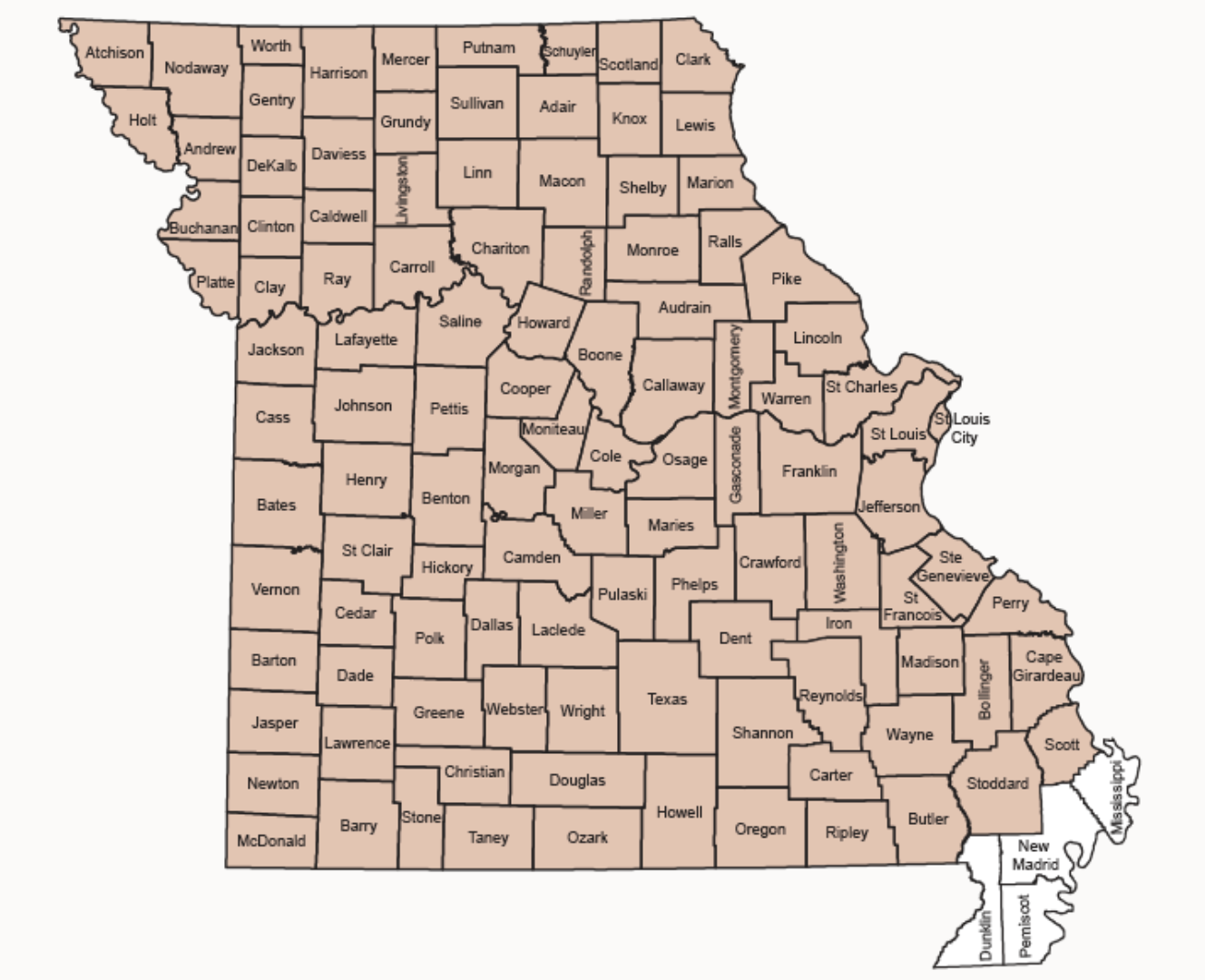
How Many Firearms Antlerless Permits Can You Fill?
You may purchase as many antlerless permits as you want, but each county or county section has a limit on the number of antlerless permits you may fill. Resident landowners with at least 75 acres may harvest additional antlerless deer using no-cost Resident Landowner Firearms Antlerless Deer Hunting Permits.
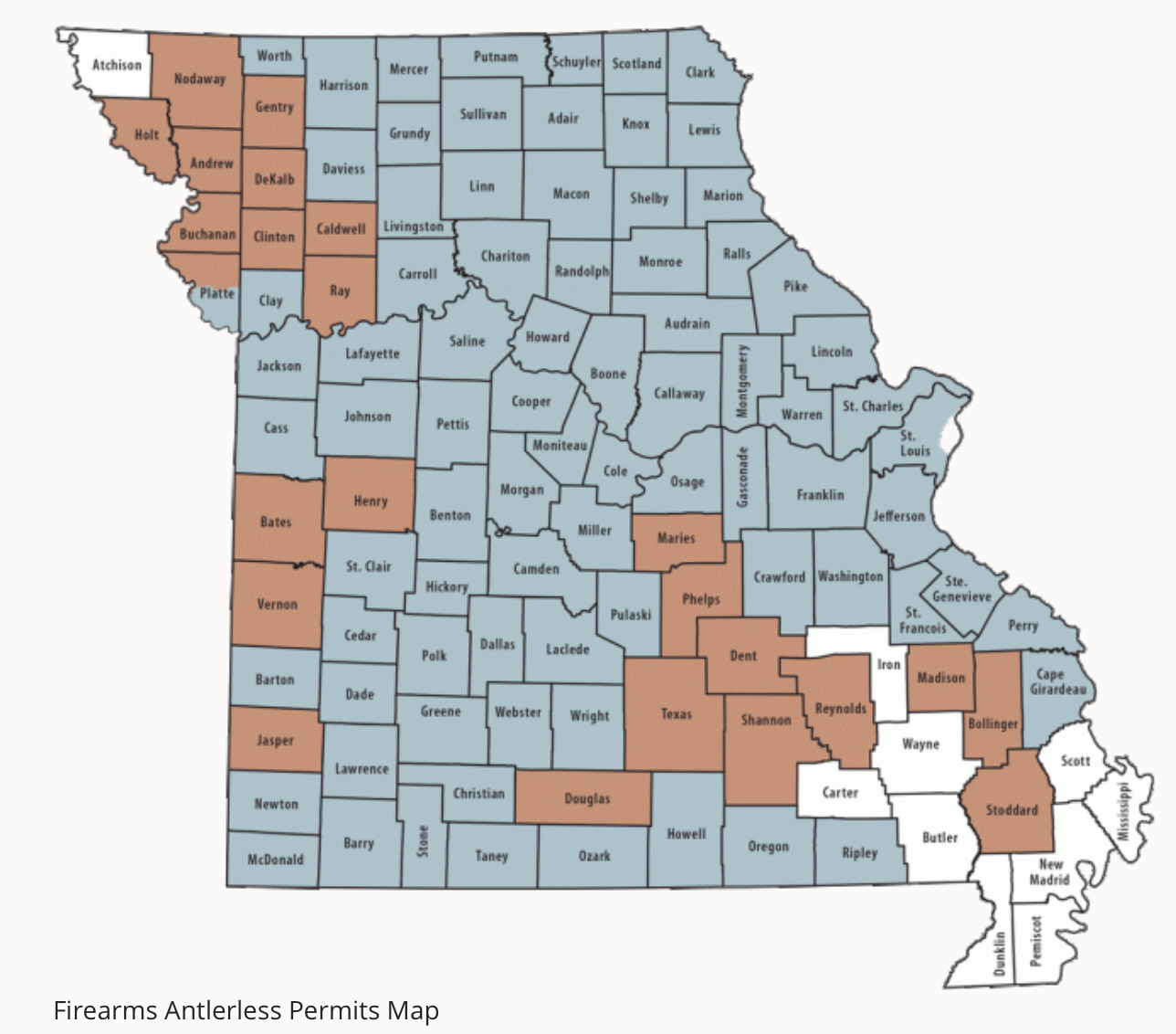
- Counties in white: During firearms season, antlerless deer may be taken only on an any-deer permit or a landowner antlerless deer hunting permit: Atchison, Butler, Carter, Dunklin, Iron, Mississippi, New Madrid, Pemiscot, Scott, and Wayne.
- Counties in brown: You may fill one firearms antlerless deer hunting permit in these counties or county sections during firearms deer season (all portions combined): Andrew, Bates, Bollinger, Buchanan, Caldwell, Clinton, DeKalb, Dent, Douglas, Gentry, Henry, Holt, Jasper, Madison, Maries, Nodaway, Phelps, Ray, Reynolds, Shannon, Stoddard, Texas, and VernonResident landowners with at least 75 acres may harvest additional antlerless deer using no-cost Resident Landowner Firearms Antlerless Deer Hunting Permits.
- Counties in blue: You may fill two firearms antlerless deer hunting permits in these counties or county sections during firearms deer season (all portions combined). Resident landowners with at least 75 acres may harvest additional antlerless deer using no-cost Resident Landowner Firearms Antlerless Deer Hunting Permits. Adair, Audrain, Barry, Barton, Benton, Boone, Callaway, Camden, Cape Girardeau, Carroll, Cass, Chariton, Christian, Cedar, Clark, Clay, Crawford, Cole, Cooper, Dade, Dallas, Daviess, Franklin, Gasconade, Greene, Grundy, Harrison, Hickory, Howard, Howell, Jackson, Jefferson, Johnson, Knox, Laclede, Lafayette, Lawrence, Lewis, Lincoln, Linn, Livingston, Macon, Marion, McDonald, Mercer, Miller, Moniteau, Monroe, Montgomery, Morgan, Newton, Oregon, Osage, Ozark, Perry, Pettis, Pike, the portion of Platte County included in the Kansas City urban zone, Polk, Pulaski, Putnam, Ralls, Randolph, Ripley, Saline, Schuyler, Scotland, Shelby, St. Charles, St. Clair, St. Francois, St. Louis, Ste. Genevieve, Stone, Sullivan, Taney, Warren, Washington, Webster, Worth, and Wright.
Antlerless Portion of the Firearms Season
Firearms hunting is allowed only in counties shaded blue or orange in the map below. Areas in white are closed to firearms hunting during the antlerless portion.
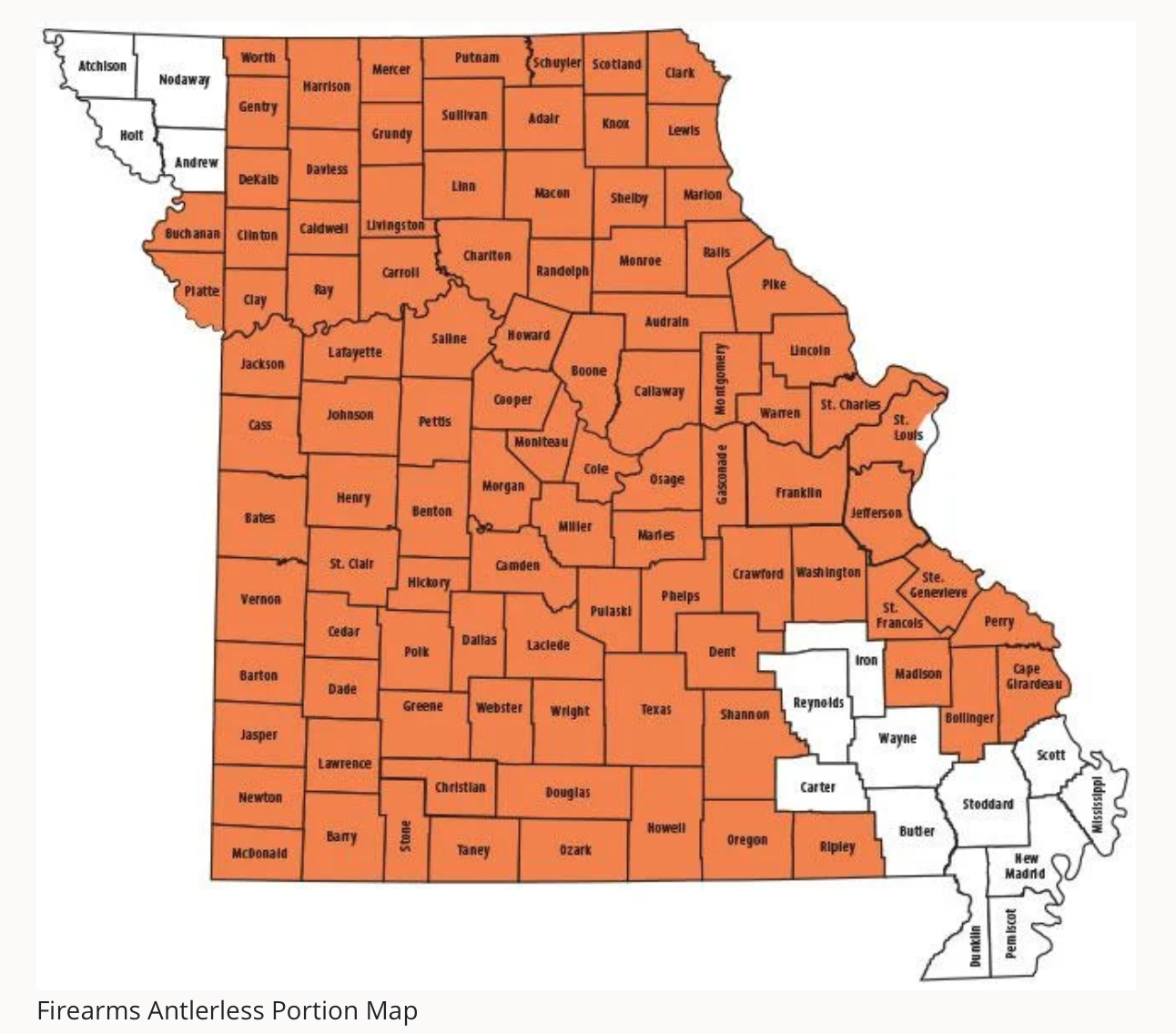
Counties closed to firearms hunting during the antlerless portion: Andrew, Atchison, Butler, Carter, Dunklin, Holt, Iron, Mississippi, New Madrid, Nodaway, Pemiscot, Reynolds, Scott, Stoddard, and Wayne.
Antler Point Restrictions
What are antler point restrictions?
In Missouri counties with antler restrictions, an antlered deer must have at least four points on one side to be taken.
How to count antler points
Each of the following counts as a point:
- The end of the main beam
- An antler point, if it is at least 1 inch long
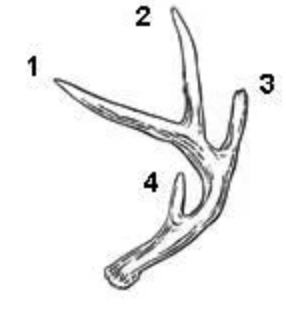
- Any broken tine that is at least 1 inch long
- The brow tine, if it is at least 1 inch long
Tines, main beams and brow tines all count as a point if they are at least 1-inch long. A buck with seven points is a legal deer in counties with antler-point restrictions.
Counties with a 4 antler point minimum
These counties require that bucks you harvest have at least four antler points on one side of their rack. This rule applies to both the archery and firearms deer hunting seasons. It does not apply to youth portions of the firearms deer season.
- Andrew
- Atchison
- Audrain
- Barton
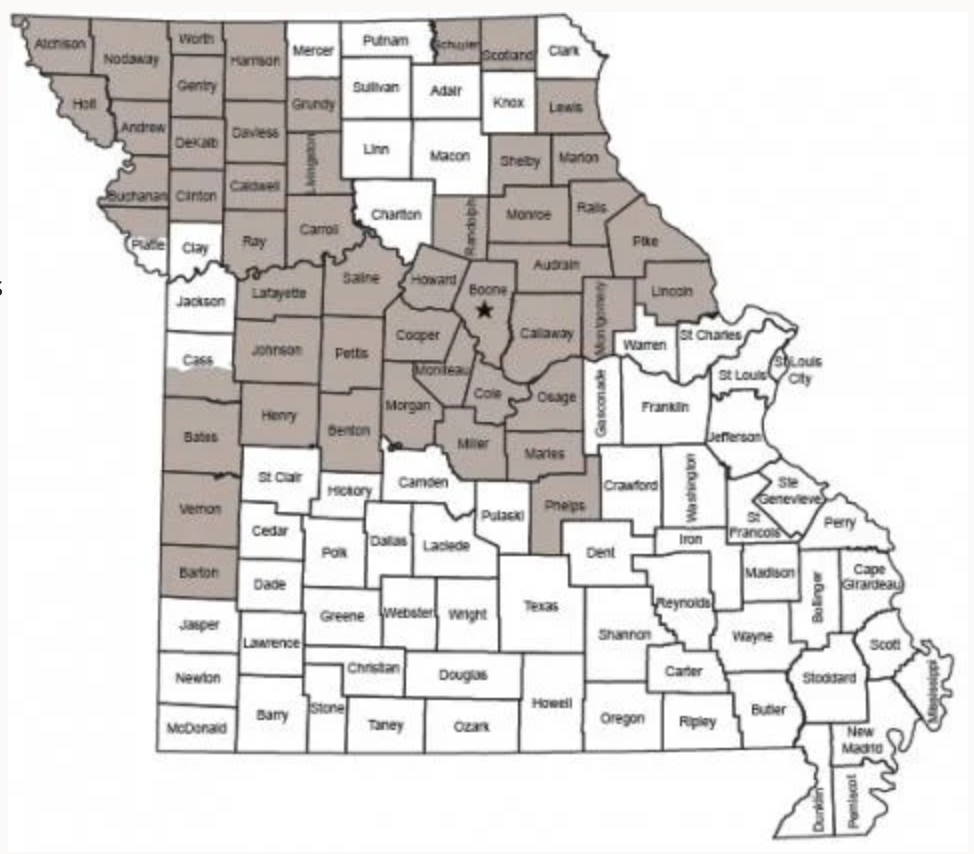
- Bates
- Benton
- Boone (does not apply within the city limits of Columbia)
- Buchanan
- Caldwell
- Callaway
- Carroll
- Cass (applies to part of county)
- Clinton
- Cole
- Cooper
- Daviess
- DeKalb
- Gentry
- Grundy
- Harrison
- Henry
- Holt
- Howard
- Johnson
- Lafayette
- Lewis
- Lincoln
- Livingston
- Maries
- Marion
- Miller
- Moniteau
- Monroe
- Montgomery
- Morgan
- Nodaway
- Osage
- Pettis
- Phelps
- Pike
- Platte (applies to part of county)
- Ralls
- Randolph
- Ray
- Saline
- Schuyler
- Scotland
- Shelby
- Vernon
- Worth
Legal
Does, button bucks and bucks with spikes less than 3 inches are legal to take on Antlerless or Any-Deer Permits; but for deer management, it is better to take does.

Protected
Protected deer include all antlered deer (defined as having at least one antler 3 inches or longer) that do not have a minimum of at least four points on one side.
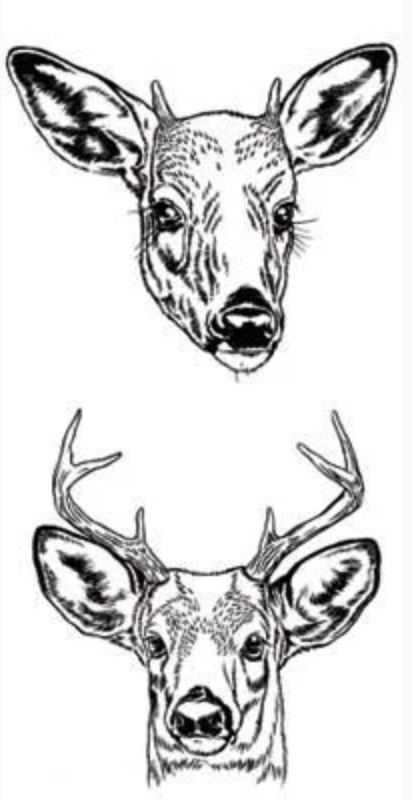
Chronic Wasting Disease Regulations
The CWD Management Zone includes counties within approximately 10 miles of CWD detections. Special regulations apply in these counties.
For the 2022 deer seasons, the CWD Management Zone includes Adair, Barry, Camden, Cedar, Chariton, Christian, Clark, Crawford, Franklin, Gasconade, Hickory, Howell, Jefferson, Knox, Laclede, Linn, Macon, McDonald, Mercer, Oregon, Ozark, Perry, Polk, Pulaski, Putnam, St. Charles, St. Clair, St. Francois, Ste. Genevieve, Stone, Sullivan, Taney, Warren, and Washington counties.
Fall 2022 Mandatory CWD Sampling
If you harvest a deer from counties in the CWD Management Zone during Nov. 13 or 13, 2022, you must take your deer — or just the head — on the day of harvest to a CWD sampling station. Hunters are reminded to follow new carcass transport regulations when traveling to CWD sampling stations.
Special Regulations for the CWD Management Zone
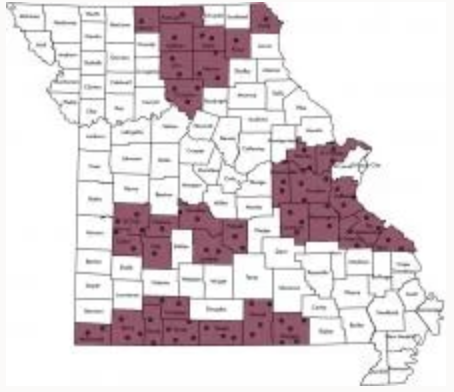
Carcass Movement Restrictions
- All deer harvested from CWD Management Zone counties must be Telechecked before any parts are transported out of the county of harvest.
- Hunters wishing to transport any part of the deer with the spinal column or brain present may only do so if within 48 hours of exiting the county if they deliver the carcass to a meat processor or the head to a taxidermist or an approved MDC CWD sampling site.
- The following parts may be transported out of CWD Management Zone counties without restriction:
- Meat that is cut and wrapped or that has been boned out
- Quarters or other portions of meat with no part of the spinal column or head attached
- Hides from which all excess tissue has been removed
- Antlers or antlers attached to skull plates or skulls cleaned of all muscle and brain tissue
- Upper canine teeth
- Finished taxidermy products
Prohibition on feeding
Grain, salt products, minerals and other consumable products used to attract deer are prohibited year-round within CWD Management Zone counties. The following exceptions are allowed:
- Feed placed within 100 feet of any residence or occupied building
- Feed placed in a manner that excludes access by deer
- Feed and minerals used solely for normal agricultural, forest management, or wildlife food plot production practices
- Feed placed as part of a feral hog or CWD management effort authorized by the Conservation Department
Other Special Regulations for the CWD Management Zone
- Antler-Point Restriction: MDC has removed the antler-point restriction for CWD-Management-Zone counties. This was done so young bucks are no longer protected from harvest because young bucks can spread the disease to new areas as they search for territories and mates.
Bringing Harvested Deer or Other Cervids into Missouri
- For deer, elk, moose, or caribou harvested out of state, only the following parts may be brought into Missouri:
- meat that is cut and wrapped or that has been boned out
- quarters or other portions of meat with no part of the spinal column or head attached
- hides from which all excess tissue has been removed
- antlers
- antlers attached to skull plates or skulls cleaned of all muscle and brain tissue
- upper canine teeth
- finished taxidermy products
- the head with the cape and not more than 6 inches of neck attached may be brought into Missouri only if taken to a licensed taxidermist within 48 hours of entry.
Hunters and Landowners Can Slow the Spread of CWD
Surveillance suggests that CWD is relatively rare in Missouri. There is hope that we can minimize the long-term impacts of the disease if we slow its spread. You can help by:
- Complying with CWD-related regulations.
- Properly disposing of deer carcasses in a permitted landfill or by burying carcasses on the property where they were harvested. (Transporting deer carcasses from the property where they were harvested and leaving them lay on the land introduces the greatest risk for disease spread.)
- Reporting sick deer to your local conservation agent or your regional Conservation Department office.
- Voluntarily testing deer harvested in the CWD Management Zone outside of opening weekend.
Kansas City Deer Hunting Zone
Kansas City urban zone
- Portion of Platte County south of Hwy 92
- Portion of Cass County north of Route 2
- All portions of Clay and Jackson counties
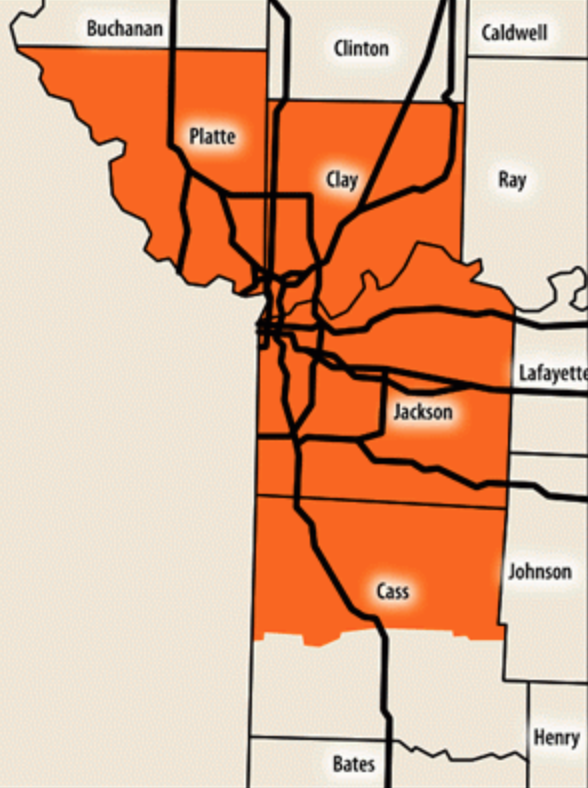
General Hunting Regulations
Methods
Seasons, permits, and species have specific rules governing the type of firearm, bow, atlatl, and slingshot which may be used to hunt. Review the information in those areas before hunting.
Fully automatic weapons are prohibited for all hunting.
Firearm restrictions during deer firearms season
During the November and antlerless portions, other wildlife may be hunted only with a shotgun and shot not larger than No. 4 or a .22 or smaller caliber rimfire rifle. This does not apply to waterfowl hunters, trappers, or to landowners on their land.
If you are hunting furbearers during daylight hours during firearms deer season, only deer hunting methods may be used.
Firearm restrictions during elk firearms portion
During the firearms portion of the elk hunting season in open counties, other wildlife may be hunted only with a shotgun and shot not larger than No. 4 or a .22 or smaller caliber rimfire rifle. This does not apply to waterfowl hunters, trappers, or to landowners on their land.
Poisons, tranquilizing drugs, chemicals, and explosives
Poisons, tranquilizing drugs, chemicals, and explosives may not be used to take wildlife.
Motor driven transportation
Motor driven transportation may not be used to take, drive or molest wildlife.
A motorboat may be used to hunt wildlife, except bear, deer and elk, if the motor is shut off and the boat’s forward progress has stopped.
All-terrain vehicles (ATVs)
It is illegal for anyone (except landowners and lessees on land they own or lease and certain agricultural workers) to drive all-terrain vehicles (ATVs) in Missouri’s streams and rivers unless the ATV is on a crossing that is part of the highway system. Violators could lose their fishing and hunting privileges.
With limited exceptions, all-terrain vehicle use is prohibited on conservation areas. Other vehicles are restricted to graveled and paved roads and established parking areas, unless otherwise posted.
Artificial lights
Artificial lights may be used to hunt:
- bullfrogs
- green frogs
- raccoons and other furbearing animals when treed with the aid of dogs
- coyotes from February 1 – March 31 in conjunction with other legal hunting method
Landowners may use artificial lights on their property, but while doing so may not be in possession of — or be in the company of someone who possesses — a firearm, bow, or other implement used to take wildlife.
Artificial lights may not be used to search for, spot, illuminate, harass, or disturb other wildlife than the above.
Night Vision and Thermal Imagery
You may not possess night vision or thermal imagery equipment while carrying a firearm, bow, or other implement used to take wildlife, except:
- To take coyotes from February 1 – March 31 in conjunction with other legal hunting methods
- For the purposes of killing feral swine by landowners or their authorized representatives on the landowner’s property
- With written authorization of an agent of the department
Calls
Mouth and hand calls may be used any time.
Electronic calls or electronically activated calls may be used to pursue and take crows and furbearers. They may also be used to take light geese during the Conservation Order. Electronic calls may not be used with artificial light or night-vision equipment, except when hunting coyotes from February 1 – March 31 in conjunction with other legal hunting methods.
Dogs
Dogs may be used in hunting wildlife -- except bear, deer, elk, turkey, muskrat, mink, river otter, and beaver. Learn more about the rules for hunting with dogs.
During a hunt
Furbearer dens or nests
The dens or nests of furbearers shall not be molested or destroyed.
Hunter orange
For your safety, you are urged to wear hunter orange whenever you are hunting. You are required to wear hunter orange at certain times and locations. Learn more about the hunter orange rules.
Hunting near flood waters or fire
Wildlife, except waterfowl, may not be pursued or taken while trapped or surrounded by floodwaters or while fleeing from floodwaters or fire.
Hunting and trapping on public roadways
You may not take any wildlife from or across a public roadway with a firearm, bow or crossbow. A Conibear-type trap may be used adjacent to public roadways only if set underwater in permanent waters.
After a successful hunt
Excessive waste
It is illegal to intentionally leave or abandon any portion of any wildlife that is commonly used as human food.
Possessing, transporting, and storing wildlife
You must keep any wildlife you take separate or identifiable from that of any other hunter.
You can possess and transport wildlife as part of your personal baggage. It may be stored at your home, camp, place of lodging or in a commercial establishment.
Proper labeling
When storing bear, deer, elk, and turkey, it must have the hunter's:
- Full name
- Address
- Date taken
- Telecheck confirmation number
When storing wildlife other than bear, deer, elk, or turkey, it must have the hunter’s:
- Full name
- Address
- Permit number
- Species
- Date it was placed in storage
When transporting wildlife other than bear, deer, elk, or turkey, it must have the hunter’s:
- Full name
- Address
- Permit number
- Date it was taken
Buying and selling pelts, feathers, and other parts
Unless federal regulations prohibit, you may buy, sell or barter legally obtained:
- feathers
- squirrel pelts
- rabbit pelts
- groundhog pelts
- turkey bones
- turkey heads
- turkey feet
- deer heads (except those acquired with a disposition form)
- elk heads (except those acquired with a disposition form)
- deer and elk antlers
- deer and elk hides
- deer and elk feet
- NOTE: Regardless of the state of harvest, black bear gallbladders may not be bought, sold, offered for sale, transferred, or given away. Extracted black bear gallbladders may not be transported into or within Missouri.
They must be accompanied by a bill of sale showing:
- the seller’s full name, address
- the number and species of the parts
- the full name and address of the buyer
Wildlife and wildlife parts, after mounting or tanning, also may be bought and sold.
People who receive or purchase deer or elk heads or antlers attached to the skull plate must keep the bill of sale as long as the heads or antlers are in their possession. The bill of sale must include the transaction date and a signed statement from the sellers attesting that the deer or elk heads and antlers were, to their knowledge, taken legally.
Giving away wildlife
You may give wildlife (excluding bear gall bladders) to another person, but it will continue to be a part of your daily limit for the day when taken. Wildlife received as a gift will be included in the possession limit of the person you give it to.
Bear, deer, elk, and turkey must be properly labeled as outlined above.
All other wildlife being given away must be labeled with:
- your full name
- address
- permit number
- species
- date taken
Hunting With Dogs
Hunters may use dogs to take and retrieve game, but there are restrictions by species, times, and locations.
When Dogs are Illegal to Use
Dogs are prohibited when hunting deer, elk, and turkey.
Dogs can not be used to harvest muskrat, mink, river otter, and beaver.
Dogs are prohibited when hunting furbearers (badger, bobcat, coyote, gray fox, opossum, raccoon, and striped skunk) during daylight hours from Nov.1 through the close of the November portion of the firearms deer season and in counties that have an antlerless portion of the deer season.
Dogs are prohibited when hunting squirrels and rabbits during daylight hours of the November portion of the firearms deer season in the following counties:
- Butler
- Carter
- Dent
- Iron
- Madison
- Oregon
- Reynolds
- Ripley
- Shannon
- Wayne
Dogs are prohibited when hunting squirrels, rabbits, and furbearers (badger, bobcat, coyote, gray fox, opossum, raccoon, and striped skunk) during daylight hours during the firearms portion of the elk hunting season in the following counties:
- Carter
- Reynolds
- Shannon
Dogs must wear ID
While hunting, all dogs, except for those used by waterfowl and game bird hunters, must wear a collar with the owner’s full name and address, Conservation Number or complete telephone number.
Training Dogs
During training, dogs may chase but not take wildlife that can be hunted with dogs. You will need a hunting permit appropriate for the wildlife or exception when training dogs that are chasing wildlife.
Only a pistol with blank ammunition may be used during daylight hours to train dogs during closed seasons.
Hunter Ethics
All hunters should treat the outdoors with respect and follow ethical hunting practices. These include:
- If you hunt on private land, be sure to obtain permission from the landowner and respect his or her property as if it were your own. Scout the area you plan to hunt so you know where the boundaries, houses, roads, fences and livestock are located on the property.
- If you do not kill your game instantly, make every effort to find the wounded animal. Permission is required to enter private land.
- Clean and care for your game properly.
- Pick up all litter, including spent ammunition. Leaving an area better than the way you found it is a sign of thanks for the privilege of hunting.
- Report observed violations of the law to a conservation agent or local sheriff as soon as possible.
- If you are involved in a firearms-related accident, the law requires that you identify yourself and render assistance; failure to do so is a Class A misdemeanor.
- Develop your skills and knowledge, and share them with others.
- Know and obey all wildlife laws.
- Know and follow the rules of gun safety.
- Respect the rights of hunters, non-hunters and landowners.
- Make every effort to retrieve and use all game.
- Respect the land and all wildlife.
- Be sensitive to others when displaying harvested game.
- Remember, hunting is not a competitive sport.
